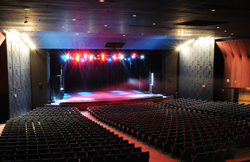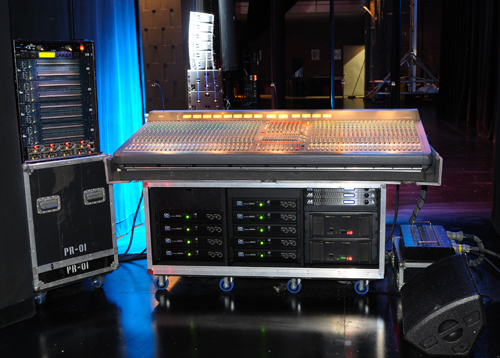
Simplifying Cable Runs
Another unique element of the build was the speed with which it was completed. Then again, they didn’t have much choice given the demands of their timeline.
Luckily, very little slowed their progress. One change necessary involved the cable run from the stage to Front of House. Previously it had gone the long way around, offstage, to the wall, up the outside of the wall and back to Front of House. “It was just too long so we ran it through the ceiling. That was really the only issue,” says Prinsloo.
In all, the install took three days. Being that the QE was already a working, if underused, theater, much of the infrastructure in terms of power and rigging was already there. “The fly pipes behind the proscenium were in good shape, there’s some nice FOH positions for lighting,” says Sandolowich.

“They might add rigging for the sound in the future,” he adds, “but, if you look at the angle where it’s sitting it’s probably bang on to where it needs to be. There’s no real elevation in this venue so there may not be any reason to fly it.”
.
Having large conduits and cable bridges already in place saved time in running snakes. “It wasn’t one of these things where we’re pulling wire for weeks. We put in pre-made snakes and the racks were wired off site, panels with loudspeaker output and line input connectors on them and twist lock power so everything just plugged in to make install time really quick,” says Sandolowich.
Having Adamson pretty much in their own backyard didn’t hurt either, added Prinsloo. The relationship between Prinsloo and Adamson goes back a ways. “I’ve known Brock Adamson for 25 years,” he says. It’s also Canadian made, and one of few domestic self-contained operations.
Between Adamson’s Benoit Cabot and Jesse Adamson the system was tweaked out in short order. After Jesse Adamson surveyed the venue, and the gear was installed, tweaking the system out using Adamson Shooter software took, essentially, a day.
“Coverage of seats is the challenge in any theater – you need it to sound even everywhere, and we achieved that,” says Prinsloo. Had there been a balcony, that would have further impacted both their equipment needs, and possibly some additional soundproofing. As it is, after the QE’s opening night crowd reaction said it all. “You know when ticket buyers notice the sound is great that’s a good thing. Sound is either great or it isn’t when you’re a ticket buyer.”
Where are they going from here? Right now the show reviews are positive, business is good and while there’s nothing they’ve found immediately that needs to change, Prinsloo has plans to augment the system in the future – with luxury items, he says – “Tube compressors, some Shure KSM 105 and Neumann microphones.”
.
Always, he stresses, with flexibility in mind. “Every tour is a little bit different and you’ve got to be able to deal with issues everyone’s issues in order to get the job done.” Not to mention keeping everyone happy.
With two of the arguably best sounding venues in Canada’s largest city in their hands, and doing well, the question is, are he and Sinopoli happy, or are they thinking about making it a trio?
“Yes,” Prinsloo says unequivocally. He’s cagey about specifics, but you can see the light behind his eyes when he talks about their next step. Clearly he’s got a plan. It’s not a question of if, but a matter of when. Which begs one last question – how? For Prinsloo, this gig may be the realization of a lifetime dream, but it’s a dream that takes up virtually every waking hour he has. Right now he’s splitting his time roughly 75-25 percent at the Mod Club and the QE respectively, occasionally working three shows a day. “The only time I don’t work here or at The Mod Club, I’m sleeping.”
Based in Toronto, Canada, Kevin Young is a freelance music and tech writer, professional musician and composer. As a founding member of Canadian rock band Moist, he toured widely, from the north Arctic of Canada to the deep south of the US, as well as Europe and Asia.
Queen Elizabeth Theatre Specifications & Gear List
Technical Specifications
Stage Floor: 48 x 35 feet
Surface: Wood
Stage Right Wingspace: 20 x 20 feet
Stage Left Wingspace: 20 x 10 feet
Grid Height: 40 feet
Risers: 6 x 4 x 8 feet
House Spots: On demand
Front Of House System Gear
1 52-channel Yamaha PM 4000
2 dbx 3231L stereo EQ
3 Drawmer DL 441 quad compressors
3 Drawmer DS 404 quad gates
1 Yamaha SPX 1000 digital multi effect
1 Yamaha SPX 990 digital multi effect
2 TC Electronic M1 reverbs
2 TC Electronic D2 delay
1 Denon 620T CD deck
Stacks & Racks
12 Adamson Y-10 line array cabinets
4 Adamson T21 subwoofers
14 QSC 2450 amplifiers
4 Lab.gruppen fp 6400
Monitor System Gear
1 58 channel Yamaha PM 3500
9 Adamson M15 bi-amped monitors
2 Adamson SX18 sidewash
5 dbx 3231L stereo 31-band graphic EQ
Microphones
8 Sennheiser 935
4 Sennheiser 604
3 Shure SM 81s
4 Shure SM-58
8 Shure SM-57
3 Shure SM-94
4 Shure SM-98
1 Shure SM-91
2 Shure Beta 52
Miscellaneous
10 DI cables
10 JDI direct boxes
80 microphone cables
50 assorted Atlas mic stands
5 12 pair sub snakes
1 WNSS, power distribution system including six 20-amp stage drops

